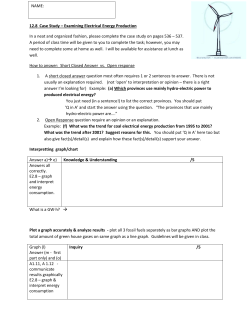
The symmetric difference metric - Individual.utoronto.ca
The symmetric difference metric Jordan Bell jordan.bell@gmail.com Department of Mathematics, University of Toronto April 12, 2015 Let (Ω, Σ, µ) be a probability space. For A, B ∈ Σ, define dµ (A, B) = µ(A4B). This is a pseduometric on Σ: dµ (A, C) = µ(A4C) = µ((A4B)4(B4C)) ≤ µ((A4B) ∪ (B4C)) ≤ µ(A4B) + µ(B4C) = dµ (A, B) + dµ (B, C). The relation A ∼ B if and only if dµ (A, B) = 0 is an equivalence relation on Σ, and dµ ([A], [B]) = dµ (A, B) is a metric on the collection Σµ of equivalence classes. We call dµ the symmetric difference metric. The following theorem shows that (Σµ , dµ ) is a complete metric space.1 Theorem 1. If (Ω, Σ, µ) is a probability space, then (Σµ , dµ ) is a complete metric space. Proof. Suppose that [Bn ] is a Cauchy sequence in (Σµ , dµ ). As for any Cauchy sequence in a metric space, there is a subsequence [An ] of [Bn ] such that dµ ([Ak ], [An ]) < 2−n for k ≥ n. Define [ En = Ak . k≥n 1 V. I. Bogachev, Measure Theory, volume I, p. 54, Theorem 1.12.16. 1 We have ∞ [ E n \ An = (Ak \ An ) k=n+1 [ = Ak \ ⊂ Aj j=n k=n+1 [ k−1 [ (Ak \ Ak−1 ) k=n+1 ∞ [ (Ak+1 \ Ak ), = k=n hence µ(En 4An ) = µ(En \ An ) ≤ ∞ X k=n Now, define A = lim sup An = n→∞ ∞ X µ(Ak+1 \ Ak ) < 2−k = 2−n+1 . k=n ∞ ∞ [ \ ∞ \ Ak = En , n=1 n=1 k=n for which µ(An 4A) = µ(An \ A) = µ An ∩ = µ An ∩ ∞ \ k=1 ∞ [ !c ! Ek ! Ekc k=1 =µ ∞ [ ! (An ∩ Ekc ) k=1 = lim µ(An ∩ Ekc ) k→∞ \ = lim µ (An \ Aj ) k→∞ j≥k ≤ lim µ(An \ Ak ) k→∞ −n <2 . Using (1), dµ (An , A) ≤ µ(En 4An ) + µ(An 4A) < 2−n+1 + 2−n = 3 · 2−n , 2 (1) showing that [An ] converges to [A] as n → ∞, and because [An ] is a subsequence of the Cauchy sequence [Bn ], it follows that [Bn ] converges to [A] and therefore that (Σµ , dµ ) is a complete metric space. Lemma 2. For A, B ∈ Σ, |µ(A) − µ(B)| ≤ µ(A4B). Proof. |µ(A) − µ(B)| = |(µ(A \ B) + µ(A ∩ B)) − (µ(B \ A) + µ(B ∩ B))| = |µ(A \ B) − µ(B \ A)| ≤ µ(A \ B) + µ(B \ A) = µ((A \ B) ∪ (B \ A)) ≤ µ(A4B). The following theorem connects the metric space (Σµ , dµ ) with the Banach space L1 (µ).2 Theorem 3. If (Σµ , dµ ) is separable then L1 (µ) is separable. 2 John B. Conway, A Course in Abstract Analysis, p. 90, Proposition 2.7.13. 3
© Copyright 2025





















